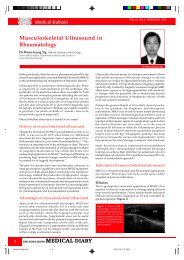Dermatology - 香港醫學組織聯會
Dermatology - 香港醫學組織聯會
Dermatology - 香港醫學組織聯會
Create successful ePaper yourself
Turn your PDF publications into a flip-book with our unique Google optimized e-Paper software.
16<br />
Pathogenesis<br />
Medical Bulletin<br />
Although candida and bacteria may be isolated, the<br />
condition is primarily not an infection. Some postulated<br />
that foreign materials which could be derived from nonviable<br />
C. albicans had been introduced into a relatively<br />
sterile nail fold. This sets up an inflammatory reaction<br />
accounting for the chronicity of paronychia. Acute<br />
exacerbations may occur and are due to secondary<br />
bacterial infections. Cultures show various organisms<br />
such as S. aureus or S. albus, Proteus spp, Escherichia<br />
coli, and Pseudomonas pyocyanea.<br />
Treatment<br />
Chronic paronychia usually gives good response<br />
to potent topical steroids. Broad spectrum topical<br />
antifungal and antibacterial solutions can be given<br />
during exacerbations secondary to superimposed<br />
fungal/bacterial infections. Patients must be educated to<br />
keep nails dry. Wet work must be avoided or else use a<br />
pair of cotton gloves under rubber gloves. Any fiddling<br />
with the nails is detrimental to healing. The affected<br />
finger nails can be temporarily covered with a porous<br />
surgical tape for protection, but prolonged occlusion<br />
aggravates. For recalcitrant paronychia, surgical excision<br />
of the NF may help. 5 Removal of nails is not necessary<br />
except if extensive Candida infection of the NP occurs.<br />
Ingrowing Nails (IGN)<br />
The condition refers to nail growing into the surrounding<br />
soft tissue. Often the toe nails especially the big toe is<br />
affected and often the lateral and medial margins of the<br />
NP grow into the sulcus and may even form a spur like<br />
projection, resulting in pain, inflammation and secondary<br />
infections. Both the finger and toe nails can be affected<br />
and it can also be bilateral.<br />
The types of IGN occur in neonates, infants and adults<br />
appear different in their predisposing causes. In the<br />
commonest types that affect adolescents and adults,<br />
a broad rigid NP, a transverse overcurvature, tight<br />
footwear and cutting the NP following the contour of<br />
the NP instead of cutting it square are said to predispose<br />
to ingrowing. Four major types are described in adults:<br />
distal nail embedding, pincer nail, juvenile IGTN and<br />
hypertrophy of the lateral lip. Distal nail embedding<br />
occurs when a distal soft tissue wall develops after nail<br />
shedding following subungual haemorrhage or nail<br />
avulsion.<br />
Management<br />
P r e v e n t i o n : t r e a t a n y p r e d i s p o s i n g f a c t o r s<br />
(onychomycosis, hallux vulgas). Trim the NP square,<br />
rather then curving them to follow the contour of the toe.<br />
If an incipient ingrowing nail is recognised, a wisp of<br />
cotton inserted under the nail plate will often permit it<br />
to ride up and out of the sulcus. In established cases,<br />
excision of the granulation tissue, antibiotics, dressings<br />
and removal of a portion of the NP and the NM (wedge<br />
excision) are indicated in order to achieve healing and<br />
VOL.15 NO.11 NOVEMBER 2010<br />
preventing recurrences. The use of a flexible plastic tube<br />
split longitudinally inserted along the NP edge as a splint<br />
allows recovery of mild forms of IGTN. This treatment<br />
principle was first advocated by Wallace et al. 6<br />
Longitudinal Melanonychia (LM)<br />
Describes the presence of single or multiple longitudinal<br />
pigmented streaks within the nail.<br />
Causes<br />
1. Focally active NM melanocytes but normal<br />
melanocyte number.<br />
2. NM melanocyte hyperplasia but without nest<br />
formation.<br />
3. NM naevus: architecture is similar to that of skin<br />
naevus with nests arranged at dermo-epidermal<br />
junction.<br />
4. Melanoma of the nail soft tissue: affects 2-3% of<br />
melanomas in Caucasians but 15-20% in Blacks. No<br />
sex predominance. Mean age 55-60 years. Mostly<br />
found in the thumbs or great toes.<br />
Features of nail melanoma<br />
1. A spot in the NB/NM.<br />
2. LM running through the whole visible nail.<br />
3. Hutchinson’s sign: brownish black pigmentation<br />
from LM on the proximal and lateral NFs. But<br />
not exact for Bowen’s disease of nail unit,<br />
hyperpigmentation only reflects rough ‘transparent’<br />
NFs (pseudo-Hutchinson’s sign).<br />
4. Others: progressive darkening of pigmentation,<br />
nail deformity, ulceration, bleeding or tumour mass<br />
breaking through the nail.<br />
Diagnostic confirmation is histologic. About 25% of<br />
melanomas are amelanotic and may mimic pyogenic<br />
granuloma, granulation tissue or IGN. Other simulators:<br />
chronic paronychia, mycobacterial infection, mycotic<br />
onychodystrophy, and subungual haematoma.<br />
Nail unit melanoma has a poor prognosis, with up to 50%<br />
of patients dying within 5 years of the diagnosis. The 5<br />
year’s survival rates were reported from 35-50%.<br />
The ABCDEF alert for subungual melanoma 7<br />
A: Age (peak incidence being in the 5th to 7th decades<br />
of life)<br />
B: Band (pigment from brown to black, breadth of 3<br />
mm or more, irregular and blurred borders)<br />
C: Change in the nail band (rapid increase in size,<br />
failure of nail dystrophy to improve with adequate<br />
treatment)<br />
D: D i g i t m o s t c o m m o n l y i n v o l v e d<br />
(thumb>hallux>index finger, single digit >multiple<br />
digits, dominant hand)<br />
E: E x t e n s i o n o f t h e p i g m e n t t o s o f t t i s s u e<br />
(Hutchinson’s sign)<br />
F: Family or personal history of dysplastic naevus or<br />
melanoma
















